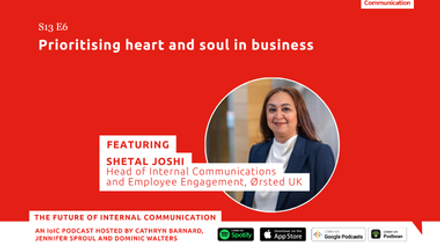How can internal communication enable purposeful organisations?
In a rapidly changing world, where organisations are having to think deeply about what they stand for and how they behave, purpose is a boardroom topic. Leaders are looking for ways they can achieve sustained improvements in their reputation and growth – and internal communicators have a key role to play.
At an IoIC roundtable debate led by Radley Yeldar, the discussion was distilled down to seven key takeaways.
1. Create a movement with IC at the centre of the purpose journey
The general consensus among the group of IC experts was that an organisation’s purpose must live and breathe throughout the business. It should connect emotionally to why the organisation exists, and should unify employees around a common goal.
For IC professionals to truly embed purpose, they need to be present at the start of its evolution and champion it for employees. They also have to sustain their influence on how the purpose is communicated. Getting your foot past the boardroom door early in the process is not easy, and the group agreed that IC professionals must position themselves as a trusted and integral part of the process.
Simon Garcia, head of communications and employee engagement for commercial banking at HSBC, said: “We’re trying to position IC differently and not sit on the periphery of issues. The ideal place for IC to be is in the middle of the process, so that we understand how the decisions that leaders make shape the purpose. We don’t want to be asked to just take their message and do something with it.
“I sit with the CIO as she writes her objectives. It’s about being at that point of influence. Rather than taking the output, you’re at the genesis. There’s a line of sight with what you do on a day-to-day basis.”
“You have to be at the discussion tables when big decisions are made,” adds Lisa Gwinnell, head of employee and leadership communications at Siemens, “but you also have to be on the ground.”
Getting employees on board with the purpose is the most important element. It can’t just be a strapline. Tam Sandeman, a communication director at Walgreens Boots Alliance, advises: “Don’t just run the purpose at your employees. It needs to be how you are – in your business’s DNA – and not just words you say at people.”
2. Help leaders and managers be visible role models of your purpose and values
The group had a unanimous point of view on the importance of supporting leaders and managers so they can engage their teams in conversations about purpose, and exhibit behaviour that supports the purpose and values.
This is not without its challenges. Tam Sandeman says: “Our job is particularly hard when someone at the top gets it, but doesn’t role model it.”
Heather Armond, head of internal communications for Allianz Global Corporate & Specialty, believes the nature of business makes it hard for leaders to consistently focus on an agreed path. “Board members can say yes, they agree, but then go back to their parts of the organisation and do something different, because there are so many competing priorities. A lot of leaders are operationally focused and, while they acknowledge that purpose is fundamental, it can take a back seat when it comes to driving the day to day activity.”
Is there an easy way to get leaders to commit? At Ciena, senior leaders made their pledges relating to the company’s vision on film at the internal launch event – and those videos are posted on the intranet and replayed as a reminder to all staff. Micaela Cook, senior director of internal comms at Ciena, says: “It’s human nature that in a crisis people will revert to type. Our leaders have said, ‘If you see me not doing the things I’ve pledged, let me know.’ Our CEO has said our purpose must be filter through which we make our decisions.”
IC experts can also play an essential role by encouraging informed employee voice and building trust in visible leaders who speak about purpose. Anita Bassi, internal comms manager at Capgemini spoke of how leaders go out on the ground to talk about vision and strategy and get direct feedback from employees. As a result, they often make decisions based on what they hear.
3. Infuse purpose in the employee experience
For a purpose to be more than just words, it needs to be a living part of the daily work experience for your people. This is where IC experts can help shape culture by infusing the purpose through communications that enhance employee engagement and performance.
At Harrods, a key objective is replicating the customer experience for employees. Niall Ryan-Jones, head of employee experience at Harrods, explains. “We have an employee value proposition that creates opportunities for us to engage with a diverse group of employees across the organisation. We’re trying to understand what prospective recruits expect and flush out what our experience looks like to get authenticity internally. That’s the closest we get to embedding purpose across the organisation – by creating what we call ‘moments of truth’.”
Creating this kind of change can’t be achieved overnight. It’s about working in stages with colleagues to build consistent messages and behaviours about purpose at every step in the employee journey – from recruitment to retirement.
4. Share stories of the purpose in action
The group agreed on the importance of showing how specific behaviours align with the organisation’s purpose, and using real business scenarios to demonstrate how purpose can be used to guide decision-making.
Cécile Jenkins, internal communications adviser at Oxfam, says: “Our mission is to end poverty and I'm sure most colleagues join Oxfam with the motivation that their role can help play a part. Internal Comms team always looks for opportunities to tell stories of what we do, changing and saving lives, to ensure we connect people to our cause and demonstrate the contributions each of us makes, whatever our role. Knowing an organisation's purpose is intrinsic to employee engagement and job satisfaction.”
5. Purpose as an enabler of change
Research shows that leaders believe one of the benefits of being purpose-driven is that it makes organisations better at change. So how were members of the group using their purpose to enable change?
Tam Sandeman of Walgreens Boots Alliance, which owns Boots, reflected on the importance of the connection between purpose and brand heritage:
“We set the context for change. For our thousands of customer-facing colleagues on the shop floor, we need to clarify the purpose for them. Why are they here? Our business is built on strong foundations of Jesse Boot, who wanted to provide affordable healthcare to people. Today we may talk more about performance, but it’s important we maintain a strong link back to our foundations.
“Last year, we produced a video that asked ‘What would Jesse do?’ It was a gentle way of joining the dots between our transformational change agenda and our roots. IWe used an emotional approach using storytelling, rather than a rational one using statistics, and it was well received. It helped people understand and connect with our need for change.”
6. Measure the impact of your purpose on performance
Lisa Gwinnell from Siemens said: “Have regular dialogues with people, either in person or virtually; that’s the importance of being ‘on the ground’. You’re not asking how they feel about the purpose, but you’re seeing if those behaviours are landing.”
In Grant Thornton, conversations around purpose on the organisation’s social platform can be measured. “We use Jive, so have access to detailed analytics on how stories that link to our purpose are being read and shared,” says Christian Hann, internal comms manager. “We can see positive reactions based on likes and comments – it’s really powerful to enable people to tell their own stories that demonstrate how our purpose is coming to life.”
Micaela Cook ran qualitative and quantitative surveys before and after the launch of Ciena’s new purpose. “We wanted to find out if people got it, and where the gaps were. We can’t affect behaviour unless people understand what we’re trying to achieve. Is their understanding manifesting itself in behaviours and are we seeing it in business performance?
“We also spoke to groups of global employees who gave us feedback. We still do that informally – and it feels exclusive to them. If it becomes too structured, the authenticity goes.”
Tam Sandeman endorses a similar approach. “We need to get both cynics and advocates to feed back. And to see if there are groups of advocates that might be overlooked, for example people who’ve been nominated for recognition awards. How could they become even more engaged in spreading the word, exciting and engaging others.”
7. Persistence pays for embedding purpose
Paulina Lezama of Radley Yedlar acknowledged that there is no holy grail to embedding purpose, but learning from peers in open discussions can help clarify the relationship between purpose and topics such as sustainability and employee engagement.
“Everyone agrees it’s vital to get your purpose right,” she says. “But it’s really important to consider what you are doing with it. Are you living the purpose rather than just using it as a strapline? Is your organisation embedding it beyond a comms perspective? It has to live in your business strategy and models and push for transformation. It’s the new way of doing business in the 21st century.”
Michael Dunmore, head of employee engagement at Radley Yeldar, believes organisations are using purpose to navigate challenges and enhance trust, employee engagement and performance. “A well-articulated and embedded purpose helps businesses rally their people around a common cause to help manage macro change and achieve sustained growth,” he says.
Radley Yeldar is an independent, London-based brand, marketing and communications agency, which has been researching purpose within organisations for the past three years, notably through its Fit For Purpose index of the brands that best put purpose into practice. Its 200-strong team of specialists has been working with multinationals, start-ups, private companies and public bodies for more than 30 years. They offer integrated services, including campaigns, reporting, sustainability and employee engagement – brought to life through film, print, digital content and platforms, and experiences.






